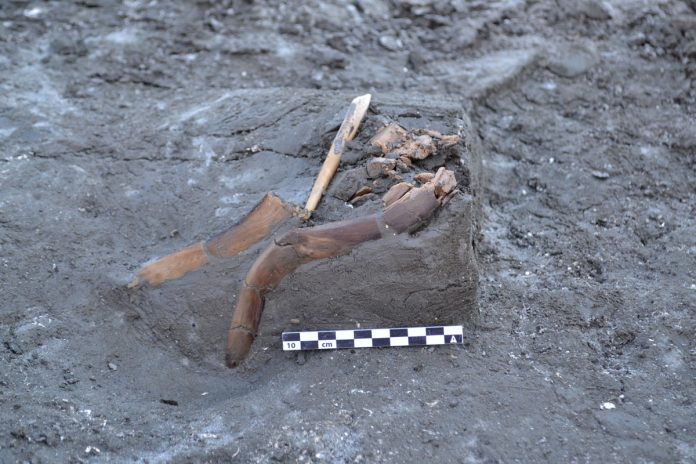At the archaeological investigations ahead of the construction of the future Fehmarn Belt Fixed Link, in Denmark archaeologists from Museum Lolland-Falster have found an object that is attracting particular attention. Jammed hard into the marine sediments and mud was the head of a fishing leister consisting of parts from both lateral prongs and a bone point slightly offset between them.
It has long been presumed that there was a link between leister prongs and bone points (as with anthropological examples), but this is probably the first time the connection has been documented in a surviving Liester spear of Neolithic date around 5,500 year-old.
“It is quite amazing that we have made a find that can help prove an old theory. So far, we have found a large number of individual leister prongs and bone points, but when we found them combined, it was quite remarkable. ” says Søren Anker Sørensen archaeologist at Museum Lolland-Falster.
The reason the archaeologists are so excited begins at Næbbet near the island of Ærø some 40 years ago where amateur archaeologist divers found a relatively well preserved leister, with parts of two lateral prongs preserved along with a piece of the shaft to which it was tied.
Previously, only individual leister prongs had been recorded, but this find finally suggested they belonged in pairs – as we know from more modern eel leisters.
However, the find immediately gave rise to a new question: Had the leisters been equipped with a centred point, as in modern leisters? The piece from Ærø did not have a point, and there were no traces of one , so archaeologists have been discussing since then whether a leister could work without a point.
It is a truth in archaeology, that just because it makes sense that the earlier artefact will mirror more recent examples, it is only with proof, that this becomes a certainty. One can almost hear the Neolithic fisherman’s curses as the head broke off their finely crafted fishing spear.
A locality with many interesting finds
During the Late Stone Age, the area now under investigation was located on the coastline of a peaceful lagoon area east of present-day Rødbyhavn. The topography made the area attractive to prehistoric communities as fishing in the coastal zone was a secure and reliable foodsource.
The prehistoric coastal zone stands out clearly in the ecavations, with a c. 20 m wide belt of scattered stones, between which a number of artefacts have been found including flint and bones – with an increasing find density towards the landward side.
A fishing paradise
Immediately south of the scattered stones, a wattle fence has been found, which extends from one of the fixed gillnets. The wattle fence stretches across about 25 metres in an arch, forming a U that opens towards the lagoon. It consists of long, slender sticks that have been intertwined closely among the almost equally slender vertical uprights. These have been placed at a distance of just 25 cm. Whether the gillnet was originally placed on this site, or whether it has washed in from the sea or been brought in for repairs or maintenance is still uncertain. The fine structure might indicate that its function was different from the more crude fishing weirs that are known from other localities in the area, and the same applies to the U-shape, if you presume that this is the original position.
Another lethal point
A broken section of hafted arrow has also been found recently, which is equally as well preserved as the fishing leister. The piece measures about 10 cm and has broken into two bits, but the point is intact with the arrowhead attached and adhesive and binding preserved, which is another thing that is only known from very few other cases.
The excavation has not yet been completed, and many unanswered questions remain about the locality and the finds made there. However, it is possible to get close to the locality and the museum’s archaeologists on 25 April 2015 when the museum opens the excavation for visitors who can learn more about the exciting traces from the past.
Read more about the open excavation here: http://www.aabne-samlinger.dk/femernforbindelsen/femernforbindelsen/nyheder/2015/aaben-udgravning/
See previous finds in Past Horizons: 5,000 year-old footprints in the sand capture a moment in time and Flawless flint dagger discovered on Danish dig and Well preserved 5,500 year-old hafted flint axe found in Denmark




